Bend Deformation |
  
|
Calling the command:
Keyboard |
Ribbon |
|---|---|
|
3D Model > Special > Deformation > Bend Deformation |
Keyboard |
Textual Menu |
<3DRB> |
Operation > Deformation > Bend Deformation |
Bend deformation allows us to bend a selected body with respect to the selected axis by a specified angle. To create this deformation, a user has to specify the deformed body, the origin and the direction of the bend axis, the angle and the bend radius.
To specify the bend axis, the angle and the bend radius, it is possible to use the special multi-element manipulator in the form of LCS with additional elements for specifying the angle and the bend radius.
|
1 - Bend angle manipulator. |
2 - Bend radius manipulator. |
3 - Bend LCS manipulator. The X axis (red) is the axis of bend. |
4 - Plane, that separates bent and non-bent parts of the body. It passes through the axis of bend and defines the base for bend angle calculation. |
5 - Plane that represents the end of the deformed area. |
The angle and radius of bending can be specified both with the help of the manipulator and as the numeric values in the command's parameters window.
The bend radius defines the position of the “neutral” surface. For the source body, this is the plane that turns into the cylinder on the bent body. The points lying on this surface do not undergo the tension or compression deformation.
In this operation, it is possible to quickly change the part of the body being deformed, and also, create two-sided bending (with respect to the dividing plane).
As in the sculpt deformation, in the bend deformation it is also possible to modify the size of the deformation area (the size of the deformation area bounding box). By default, it spans the entire body.
|
The deformation area spans the entire body |
|
The deformation area spans only a part of the body |
Creating Bend Deformation
After invoking the Bend Deformation command, follow these steps:
1.Select a body to be deformed;
2.Specify the LCS for deformation area calculation (if necessary);
3.Define an origin and a direction of a bend axis and a starting position of a bent area using the LCS manipulator;
4.Select deformation area (if necessary);
5.Specify the bend radius and the bend angle;
6.Select the mode of creating deformation (deformation of the selected part of the body, deformation of the opposite part or two-sided deformation);
7.Complete the operation creation by pressing ![]() .
.
Selection of Deformed Body
To select the deformed body, the following option of the automenu is used:
|
<O> |
Select Body to Deform |
This option is turned on by default upon the entry into the command. The deformed body is selected with the help of ![]() in the 3D window or in the tree of the 3D model. The selected body is highlighted.
in the 3D window or in the tree of the 3D model. The selected body is highlighted.
By default the bounding box of the deformation area is calculated with respect to the axes of the selected operation's coordinate system. It is possible to switch between bounding box based on global LCS and based on LCS of the selected operation using the following automenu options, which are grouped into a drop-down list:
|
<1> |
LCS by global coordinate system |
|
<2> |
LCS based on operation |
Upon switching an LCS, the bounding box is automatically recalculated in accordance to the new axes orientation.
Selection of Bend Axis and Body-Dividing Plane
After selection of the deformed body, the manipulator for specifying LCS of bending appears in 3D scene. By default, the axes of the manipulator are oriented along the sides of the bounding box of the deformation area. The axis of bending coincides with the X-axis of the manipulator. The plane that separates the bent and unbent parts of the body is defined as the XY-plane of the manipulator.
The manipulator of the bending deformation can be operated in the same way as described for the Transformations of 3D elements. By default, transformations applied to the manipulator are displayed in the separate window. You can switch the window to the auto-hiding mode ![]() or close it
or close it ![]() using buttons located in the right side of the window's header.
using buttons located in the right side of the window's header.
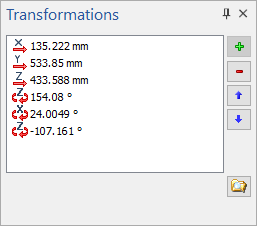
When the window is closed, transformations are displayed in the command's parameters window.
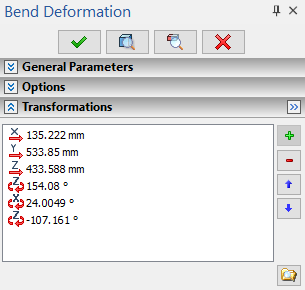
Specifying Bend Angle and Radius
A user can specify the numeric parameters of bending deformation – bend angle and bend radius – in different ways. The exact values of these parameters can be specified in the command's parameters window (Radius and Angle parameters ). Or they can be defined by using the manipulators in the 3D window.
To specify values of angle and radius using the manipulators, bring the cursor to the corresponding manipulator, press ![]() and without releasing the pressed mouse button, move the manipulator to the desired location. It is also possible to press
and without releasing the pressed mouse button, move the manipulator to the desired location. It is also possible to press ![]() after selection of the corresponding manipulator. In this case, the manipulator will start follow dynamically the cursor. To fix the desired position of the manipulator, it is required to press
after selection of the corresponding manipulator. In this case, the manipulator will start follow dynamically the cursor. To fix the desired position of the manipulator, it is required to press ![]() again.
again.
Commands for defining values of radius and angle by position of existing 3D points are available in the contextual menu of the angle and radius manipulators. You can also call the manipulator settings dialog similar to the one described in the Transformations of 3D Elements chapter.
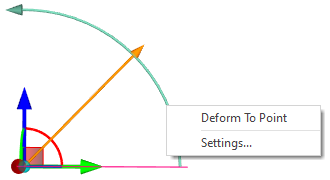
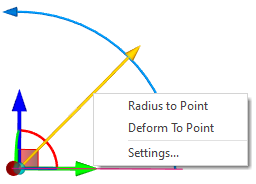
You can switch the direction in which the bend angle is measured using the ![]() button in the command's parameters window .
button in the command's parameters window .
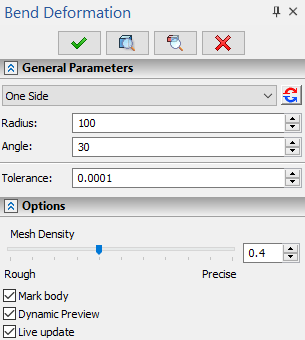
Selection of Bending Mode.
The mode of creating deformation can be selected in the Mode drop-down list of the command's parameters window. By default, the One Side option is selected, which means that the deformation will be applied only to one part of the initial body (the part which is chosen by the system by default). If a user wants to apply the deformation to another part of the body, he should select the Opposite Side option .

For creating two-sided deformation, that is bending of both parts of the body, the Symmetric option should be used.
Modifying Size of Deformation Area
The bounding box of the deformation area initially spans the entire body. For modifying the size of the deformation area, as in the sculpt deformation, the following option of the automenu is used:
|
<D> |
Change Deformation Box |
Modifying the deformation area is carried out similarly to the sculpt deformation. To exit the mode of modifying the size of the deformation area, in the automenu turn off the option ![]() .
.